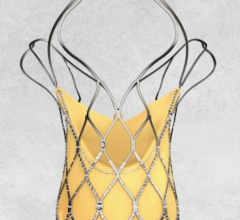September 14, 2007 - In the largest study of its kind to date, comparing the CYPHER Sirolimus-eluting Coronary Stent and the Taxus Stent to bare-metal stents, researchers found that the mortality risks associated with drug-eluting stents and bare-metal stents are similarly low.
The study involved a network meta-analysis of 38 randomized controlled trials encompassing more than 18,000 patients. The analysis also found a substantial reduction in the risk of myocardial infarction and reintervention with the CYPHER Stent when compared to bare-metal stents and the Taxus Stent, and no significant differences in the rates of stent thrombosis between the CYPHER Stent and bare-metal stents. The data from this analysis also identified a significant decrease in the risk of blood clots occurring more than 30 days after stent implantation with the CYPHER Stent compared to the Taxus Stent.
"This large set of data indicates that the mortality associated with drug-eluting stents and bare-metal stents is comparable," stated Christoph Stettler, M.D., from the University of Bern, Switzerland, one of the authors of the study. Dr. Stettler is with the Department of Endocrinology, Diabetes and Clinical Nutrition there.
In addition, the corresponding author, Peter Juni, M.D., head of Division, Clinical Epidemiology and Biostatistics, University of Bern in Switzerland, stated that, "These results have also led us to conclude that the CYPHER Stent is clinically superior to bare-metal stents and the Taxus Stent when the safety and effectiveness outcomes in this analysis are taken into account."
The study included data up to four years of follow-up. The safety outcomes comprised mortality, myocardial infarction and Academic Research Consortium (ARC) definite stent thrombosis. The effectiveness outcome was target lesion revascularization.
The mortality rates were similar for all three stents: hazard ratios (HR) were 1.00 (95 percent credibility interval 0.82 to 1.25) for the CYPHER Stent versus bare-metal stents, 1.03 (CI 0.84 to 1.22) for the Taxus Stent versus bare-metal stents and 0.96 (CI 0.83 to 1.24) for the CYPHER Stent vs. the Taxus Stent.
The CYPHER Stent was associated with the lowest risk of myocardial infarction. The corresponding hazard ratios were 0.81 versus bare-metal stents (CI 0.66 to 0.97, p=0.030) and 0.83 versus the Taxus Stent (CI 0.71-1.00, p=0.045).
The ARC definite stent thrombosis rates between the CYPHER Stent and bare metal stents were not significantly different over the entire follow-up. However, the risk of late stent thrombosis was more than twice as likely with the Taxus Stent compared to bare-metal stents (HR 2.11, CI 1.19-4.23, p=0.017). In addition, the study found that a late stent thrombosis event was 46 percent less likely to occur in a patient implanted with the CYPHER Stent than in a patient who received the Taxus Stent (HR 0.54, CI 0.26-0.98, p=0.041).
The study appeared in this week’s issue of The Lancet.
For more information: www.cypherstent.com and www.cordis.com


 July 02, 2024
July 02, 2024 









